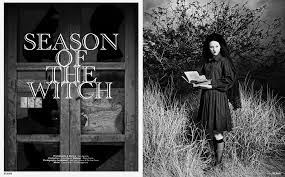
Editorial Fashion Art Witch
Introduction
Editorial Fashion Art Witch world where the fashion industry often feels synonymous with fleeting trends and commercialism, a captivating undercurrent is emerging—one that draws deeply from the well of mysticism and witchcraft. This fusion is not merely a superficial aesthetic but a profound reflection of cultural shifts, personal empowerment, and a longing for connection to the spiritual and natural worlds. As the modern witch rises in both visibility and influence, her impact on fashion is becoming increasingly significant. This editorial delves into the enchanting realm where witchcraft and fashion intertwine, revealing a unique tapestry of aesthetics, cultural significance, and sustainable practices.
1. Historical Context: The Witch in Fashion
Witchcraft in Folklore and Culture
The portrayal of witches has evolved dramatically throughout history. In ancient cultures, women often served as healers, wise women, and spiritual leaders, wielding knowledge of herbs and natural remedies. These early representations were generally positive, celebrating the wisdom and power of female figures. However, as societal fears grew—often tied to misogyny and the desire for control—witches became symbols of danger and deviance.
The witch hunts of the Middle Ages and the Renaissance are stark reminders of this transformation. Women, particularly those who deviated from societal norms, were often accused of witchcraft, leading to tragic consequences. These historical events laid the groundwork for the witch’s image as a figure of fear and otherness, yet they also sparked a fascination that continues to resonate today.
The Aesthetic of the Witch in Art and Fashion History
Art has long been a medium through which the witch’s image has been expressed. From paintings of witches flying through the night sky to the eerie, haunting aesthetics of Gothic art, the visual representation of witches has shaped public perception. The allure of the witch is often characterized by dark colors, flowing garments, and ethereal qualities.
In the 19th century, the Pre-Raphaelite Brotherhood introduced a romanticized vision of the witch, portraying her as both beautiful and tragic. These artistic representations influenced the fashion of the time, emphasizing flowing fabrics, intricate details, and a sense of mystique. Designers throughout history have drawn inspiration from these artistic movements, incorporating elements of witchcraft into their collections.
Iconic Figures and Their Influence on Modern Fashion
Throughout the decades, certain figures have emerged as icons of the witch aesthetic, leaving an indelible mark on fashion. For instance, the character of Samantha from “Bewitched” in the 1960s brought a whimsical yet stylish representation of witchcraft into the mainstream. Her iconic wardrobe, complete with chic dresses and modern hairstyles, resonated with viewers and inspired countless fashion trends.
In more recent years, pop culture figures like Stevie Nicks of Fleetwood Mac have epitomized the witch aesthetic. Nicks’s flowing gowns, lace, and layered jewelry have become synonymous with a style that celebrates femininity, mystery, and empowerment. Her influence on fashion can be seen in various collections, where designers seek to capture her ethereal spirit and rock-and-roll attitude.
2. The Aesthetic Appeal: Dark and Mystical
The Color Palette of Witchcraft: Black, Purple, and Silver
The colors associated with witchcraft evoke a sense of mystery and power. Black, often seen as a color of mourning, is also a symbol of elegance and sophistication. In fashion, black is timeless; it has the power to convey authority and confidence. When paired with deep purples and shimmering silvers, it creates a palette that feels both enchanting and otherworldly.
These colors also carry symbolic meanings. Black can represent the unknown, while purple is often associated with spirituality and transformation. Silver, reminiscent of the moonlight, connects to intuition and the subconscious. Together, they form a color palette that resonates with those who seek to embrace their inner magic.
Materials and Textures: Velvet, Lace, and Leather
The materials used in witch-inspired fashion contribute to its overall mystique. Velvet, with its rich texture and depth of color, conveys luxury and opulence. It often features in gowns and cloaks that echo the elegance of historical witches. Lace, delicate and intricate, evokes a sense of femininity and vulnerability, while also hinting at the complexities of the witch’s identity.
Leather, on the other hand, adds an edge to the aesthetic. It speaks to rebellion, strength, and defiance against societal norms. The combination of these textures creates a dynamic interplay that allows individuals to express their multifaceted identities.
Symbolism: Pentacles, Crystals, and Natural Elements
Witchcraft is steeped in symbolism, and this is reflected in fashion choices. Pentacles, moons, and various symbols from nature often adorn clothing and accessories, imbuing them with meaning and intention. Jewelry featuring crystals—each believed to possess unique properties—has gained popularity among those who embrace a witch-inspired aesthetic.
Crystals like amethyst for protection, rose quartz for love, and black tourmaline for grounding have become common motifs in jewelry design, allowing wearers to carry a piece of their spiritual beliefs with them. Additionally, natural elements such as feathers, stones, and plants are incorporated into designs, emphasizing a connection to the earth and the cosmos.
3. The Modern Witch: Fashion Icons and Brands

Influential Designers Embracing the Witch Aesthetic
Contemporary designers are increasingly embracing the witch aesthetic, creating collections that resonate with those who seek to explore their own magical identities. Designers like Ann Demeulemeester and Comme des Garçons have incorporated elements of darkness and mystique into their collections, playing with asymmetry, layering, and unconventional silhouettes. Their designs often challenge traditional notions of beauty, inviting wearers to express their individuality.
Other designers, such as Vivienne Westwood, draw from historical references and punk influences, creating garments that are both rebellious and enchanting. Westwood’s use of tartans and corsets, combined with a modern twist, reflects the spirit of the modern witch—bold, unapologetic, and deeply connected to history.
Fashion Icons Who Channel Their Inner Witch
The witch aesthetic has found champions among contemporary fashion icons who embody its spirit. Celebrities like Florence Welch, the lead singer of Florence and the Machine, often showcase flowing garments, rich textures, and mystical accessories in her performances and appearances. Her ethereal style resonates with fans, inspiring them to embrace their own unique aesthetics.
Another icon is Grimes, who merges futurism with witchcraft in her fashion choices. Her eclectic wardrobe, which combines elements of punk, goth, and fantasy, creates a powerful statement about identity and self-expression. Both Welch and Grimes encourage their followers to embrace their individuality, allowing them to explore the depths of their own magical personas.
Streetwear and the Witchcraft Revival
The resurgence of witchcraft in streetwear is a significant development in contemporary fashion. Brands like Blackcraft Cult and The Witching Hour cater to a younger audience eager to explore spirituality and self-expression. These brands often incorporate bold graphics, including witchy motifs and empowering slogans, into their designs.
Streetwear, traditionally associated with urban culture, provides a platform for witchcraft to intersect with everyday life. This movement allows individuals to express their beliefs and identities without adhering to conventional fashion norms. The fusion of comfort and style within streetwear has made it accessible, allowing more people to connect with the witch aesthetic.
4. The Role of Witchcraft in Sustainable Fashion
Slow Fashion Movement: Craftsmanship and Intention
The slow fashion movement aligns closely with the principles of witchcraft. Emphasizing craftsmanship, ethical production, and a focus on longevity, slow fashion encourages consumers to appreciate the artistry behind each piece. This perspective fosters a deeper connection between the wearer and their clothing, transforming the act of dressing into a ritual of intention and mindfulness.
In witchcraft, the act of creating—be it through sewing, knitting, or crafting—can be seen as a spiritual practice. Designers who embrace slow fashion often prioritize handmade techniques and sustainable materials, echoing the values of the witch community. This intersection of artistry and spirituality is crucial for those seeking to make conscious fashion choices.
Natural Dyes and Eco-Friendly Practices
The use of natural dyes in fashion is another area where witchcraft and sustainability intersect. Many modern designers are returning to traditional dyeing techniques, utilizing plants, fruits, and other organic materials to create vibrant colors. This practice not only reduces environmental impact but also connects the wearer to the earth in a meaningful way.
Witchcraft emphasizes the importance of nature and its resources. By using natural dyes and sustainable materials, designers honor this connection and promote a more ethical approach to fashion. Brands like Reformation and Eileen Fisher have made significant strides in integrating eco-friendly practices, showcasing that style and sustainability can coexist harmoniously.
Witchcraft as a Philosophy for Mindful Consumption
Adopting a witchcraft-inspired philosophy encourages mindful consumption, urging individuals to consider the intention behind their purchases. This mindset promotes a focus on quality over quantity, as well as an appreciation for the stories and craftsmanship behind each item.
As consumers become increasingly aware of the environmental impact of fast fashion, the principles of witchcraft offer a guiding framework for making conscious choices. This shift towards intentionality fosters a sense of responsibility, empowering individuals to curate their wardrobes in a way that reflects their values.
5. The Cultural Movement: Feminism and Empowerment
Witchcraft as a Symbol of Female Empowerment
Witchcraft has long been associated with feminist movements, serving as a powerful symbol of female empowerment and autonomy. The archetype of the witch, once vilified, is now embraced as a representation of strength, resilience, and defiance against patriarchal structures. As society evolves, the witch’s image is being reclaimed by women who seek to assert their identities and challenge societal norms.
The connection between witchcraft and feminism is particularly significant in contemporary culture, as women increasingly assert their voices and claim their power. This cultural movement encourages individuals to explore their spirituality, creativity, and self-expression, reinforcing the idea that the witch is a figure of empowerment.
The Intersection of Feminism and Fashion
Fashion plays a crucial role in the feminist movement, providing a platform for women to express their beliefs and identities. The act of dressing becomes a form of resistance, allowing women to challenge societal expectations and assert their autonomy. This intersection of feminism and fashion is particularly relevant in the context of witchcraft, as both movements encourage self-expression and authenticity.
Designers and brands that align with feminist values often incorporate empowering messages into their collections. This approach not only promotes self-acceptance but also fosters a sense of community among those who resonate with the witch aesthetic. The act of wearing these garments becomes a statement of solidarity and empowerment.
Rituals, Community, and Collective Identity in Fashion
The communal aspect of witchcraft is mirrored in the growing trend of collective identity in fashion. Witchcraft emphasizes rituals, gatherings, and shared experiences, fostering a sense of belonging among individuals who embrace this lifestyle. This communal spirit is reflected in collaborative fashion projects, pop-up events, and inclusive brands that encourage connection and support.
Fashion festivals and gatherings often celebrate witchcraft-inspired aesthetics, bringing together individuals who share a passion for spirituality and self-expression. These events create spaces for like-minded individuals to connect, share their stories, and celebrate their identities. The communal aspect of witchcraft reinforces the idea that fashion can be a powerful vehicle for collective expression and empowerment.
6. The Future of Witchcraft in Fashion
Predictions for Future Trends
As the influence of witchcraft in fashion continues to grow, several trends are likely to emerge. The integration of technology with witchcraft is one potential direction, as designers explore innovative materials and practices. The use of smart textiles, augmented reality, and wearable technology may allow individuals to engage with their clothing on a deeper level, transforming garments into interactive pieces of art.
Moreover, the emphasis on inclusivity and diversity will likely shape the future of witchcraft-inspired fashion. As more voices are included in the conversation, the witch aesthetic will continue to evolve, incorporating a wider range of identities and experiences. This evolution will create a more nuanced understanding of what it means to embody the witch archetype.
How Technology and Witchcraft May Converge
The intersection of technology and witchcraft offers exciting possibilities for the future of fashion. As digital platforms and social media continue to reshape the industry, witches and fashion enthusiasts can connect and share their stories in new ways. Virtual communities allow for the exchange of ideas, inspiration, and support, fostering a sense of belonging in the digital age.
Additionally, the use of digital design and 3D printing may revolutionize the way garments are created and worn. This technology could enable individuals to design their own witch-inspired clothing, allowing for a greater degree of personalization and self-expression. The convergence of technology and witchcraft may redefine the fashion landscape, making it more accessible and inclusive.
The Continued Relevance of the Witch Archetype
The witch archetype will remain relevant as society grapples with issues of identity, empowerment, and spirituality. The ongoing fascination with witchcraft reflects a collective yearning for deeper connections to the earth, our communities, and ourselves. As individuals seek meaning in their lives, the witch serves as a powerful symbol of self-discovery, intuition, and authenticity.
Fashion will continue to be a vehicle for exploring these themes, providing individuals with the opportunity to express their beliefs and identities. The witch aesthetic invites everyone to embrace their inner magic, reminding us that we all have the power to shape our narratives and challenge societal norms.
Conclusion
The intertwining narratives of witchcraft and fashion create a rich tapestry of cultural expression, self-discovery, and empowerment. As the modern witch rises in prominence, her influence on fashion serves as both a reflection of societal shifts and a celebration of individuality. The enchanting allure of witchcraft invites individuals to explore their own magical identities, fostering a sense of community and connection.
In a world that often feels chaotic and disconnected, the witch aesthetic offers a sanctuary—a space where self-expression, spirituality, and artistry converge. As we embrace the future, the influence of witchcraft in fashion promises to be both transformative and enchanting, paving the way for a new era of creativity, inclusivity, and empowerment.for more details please visit techwebinsights.com






